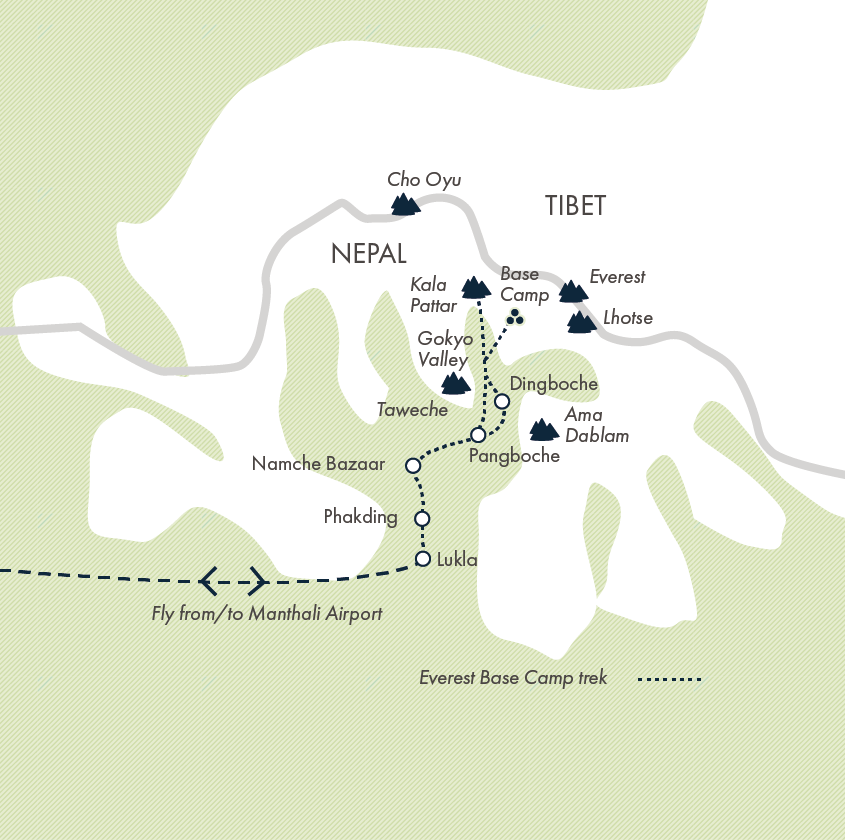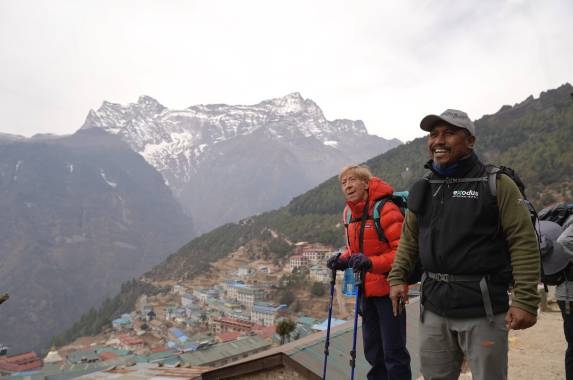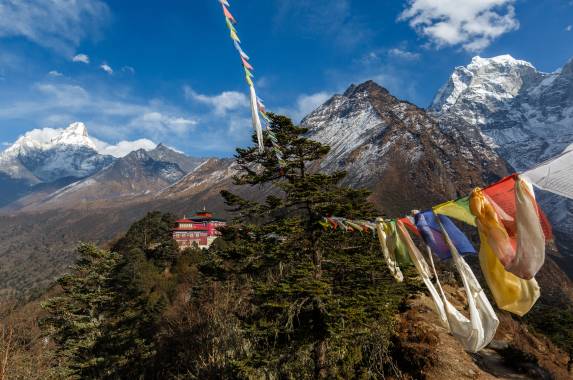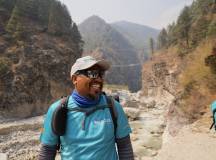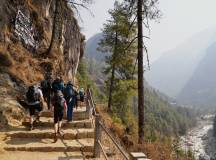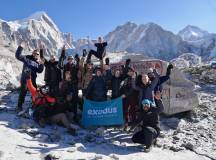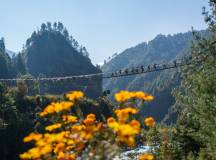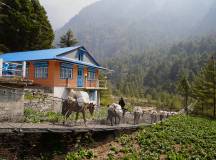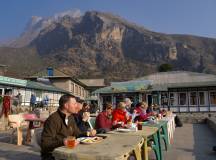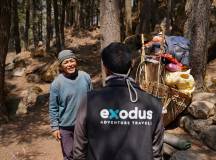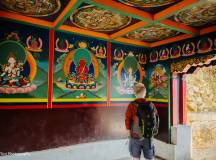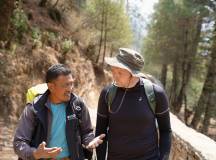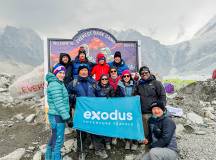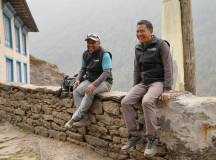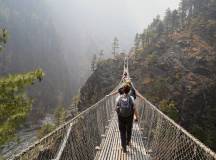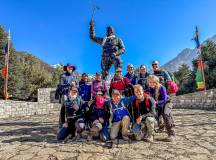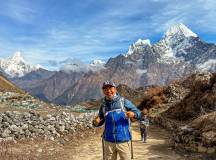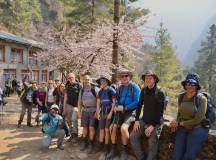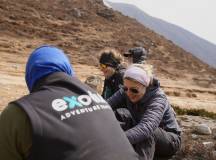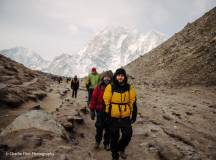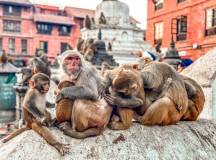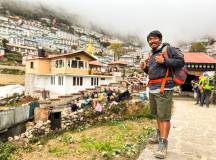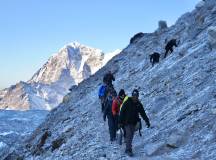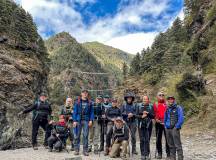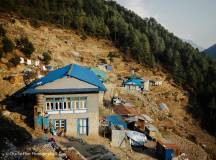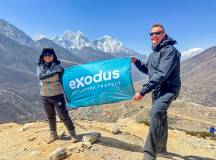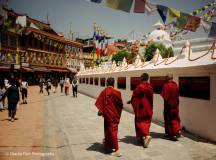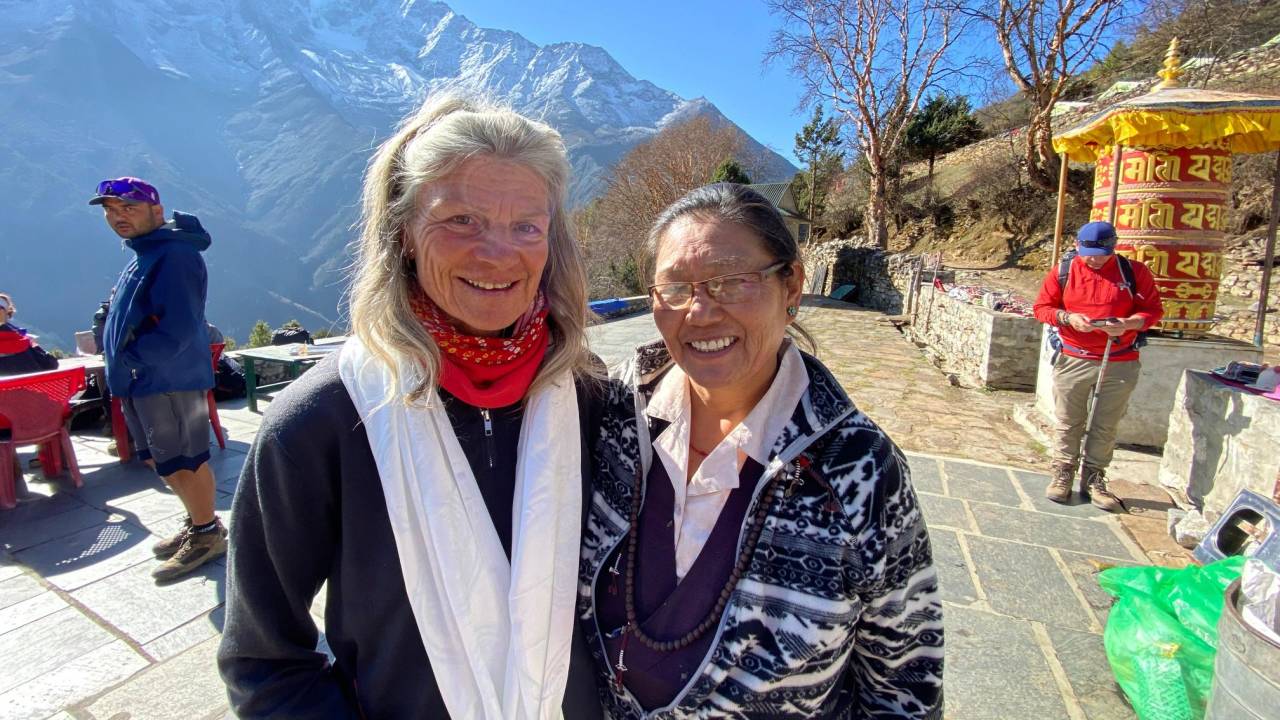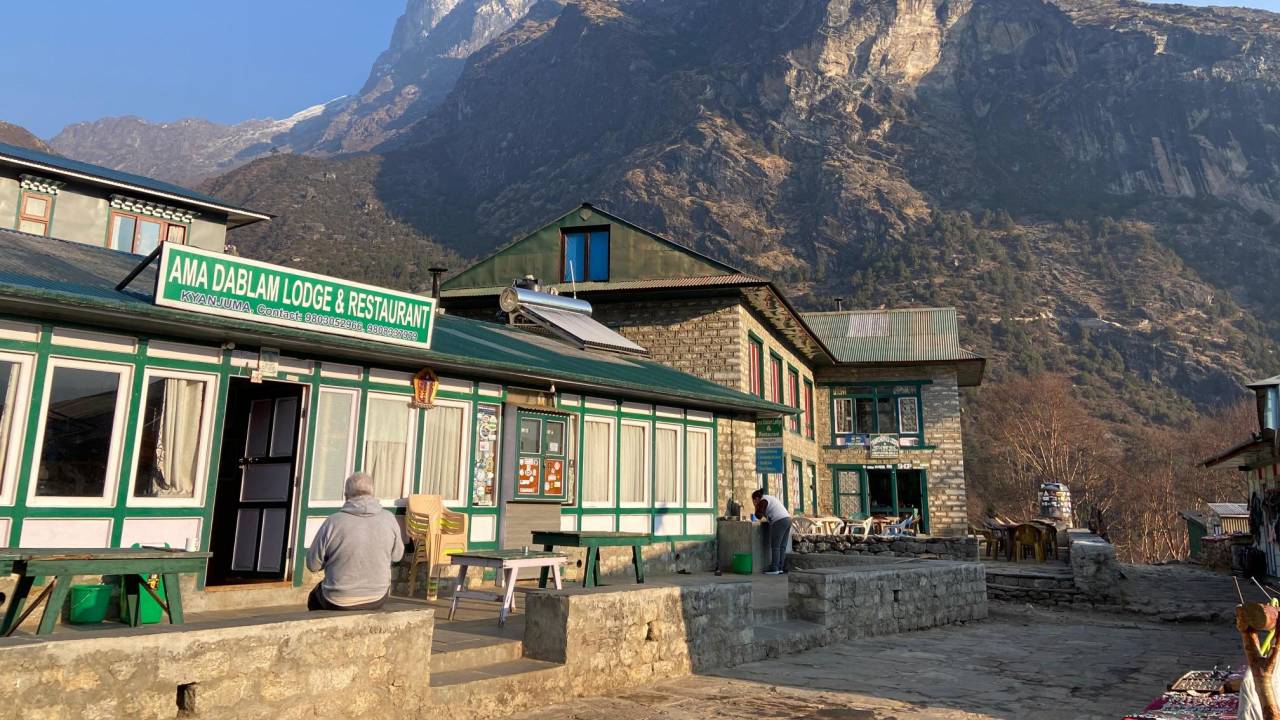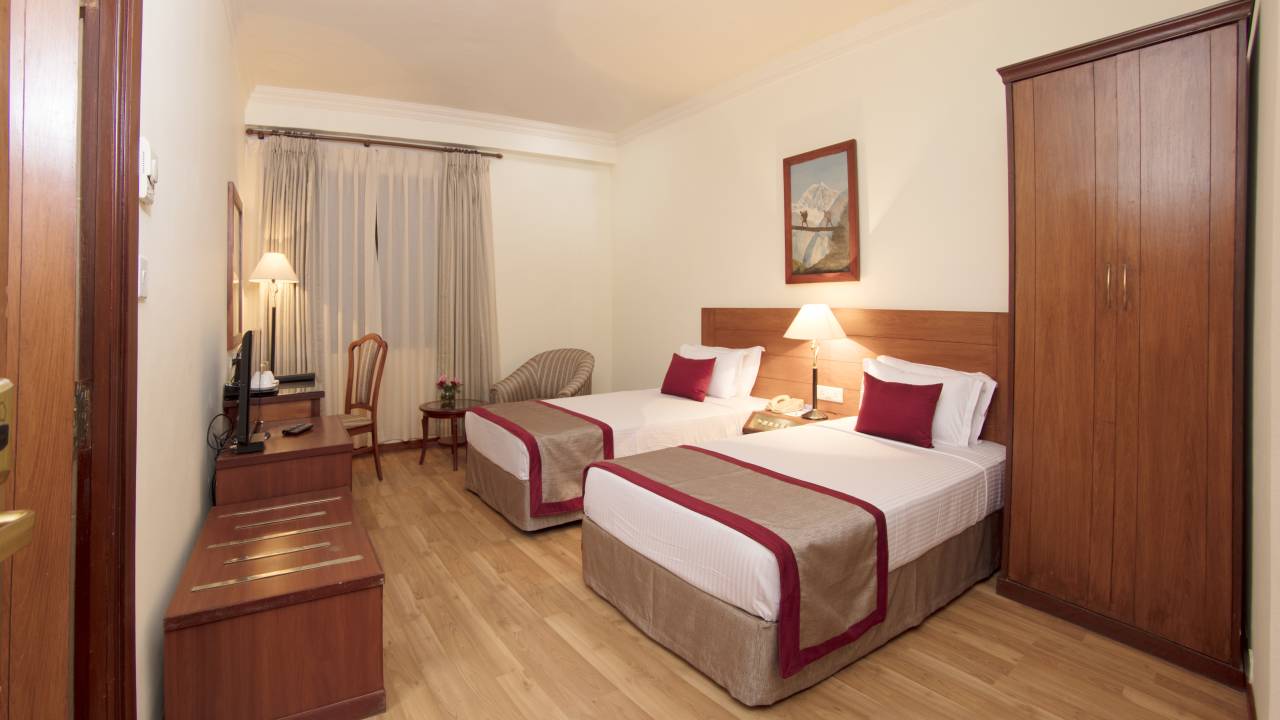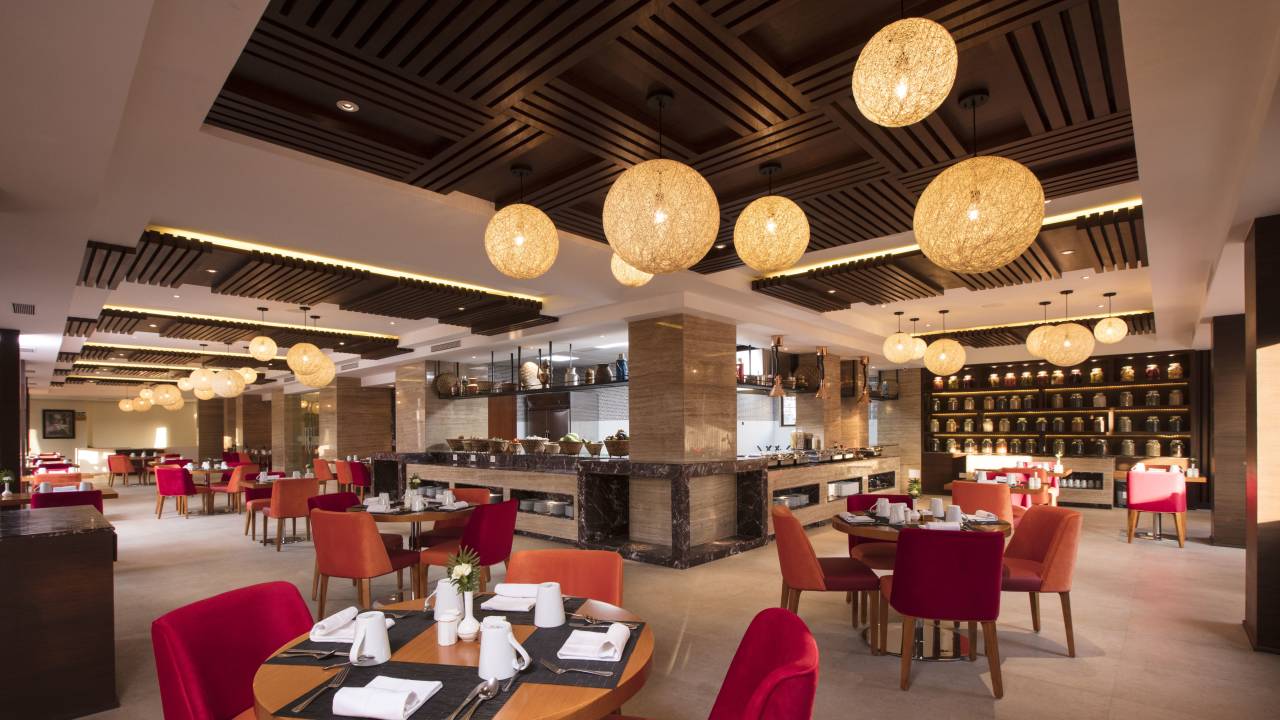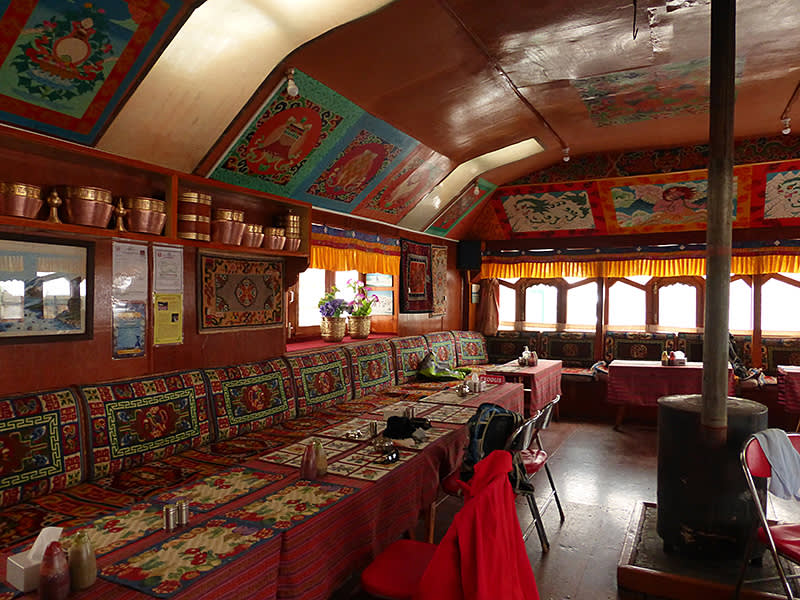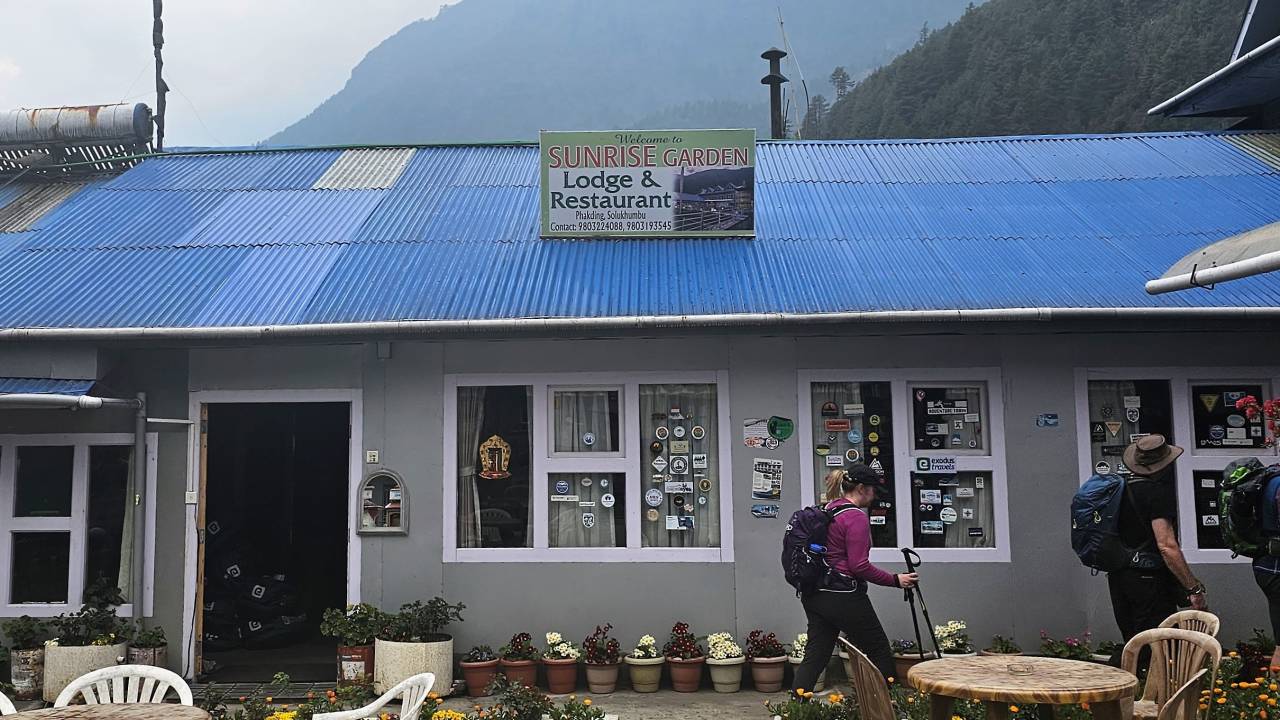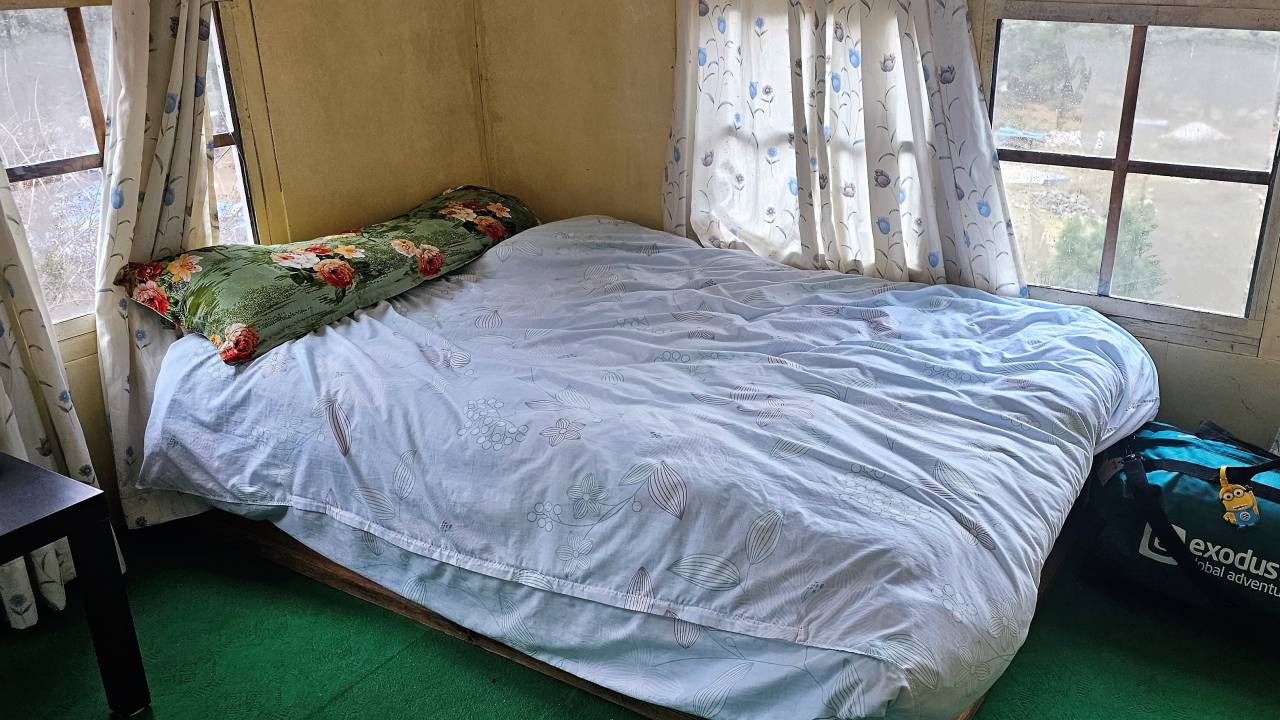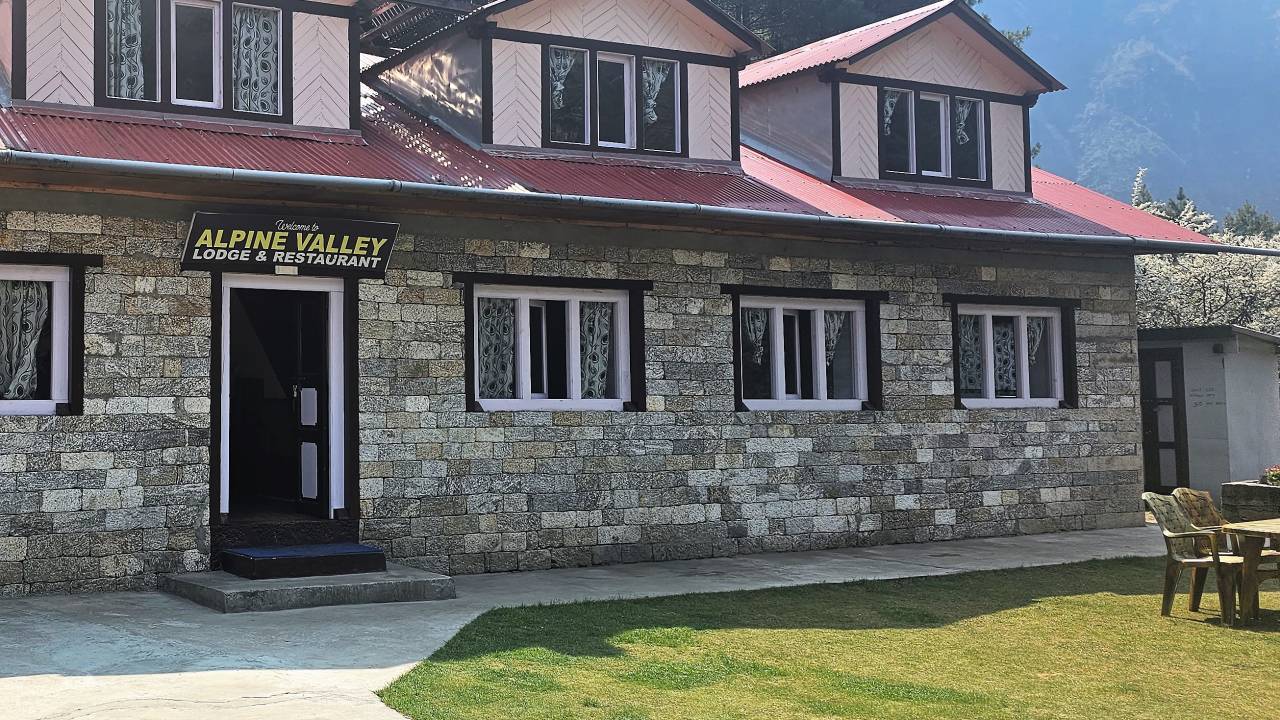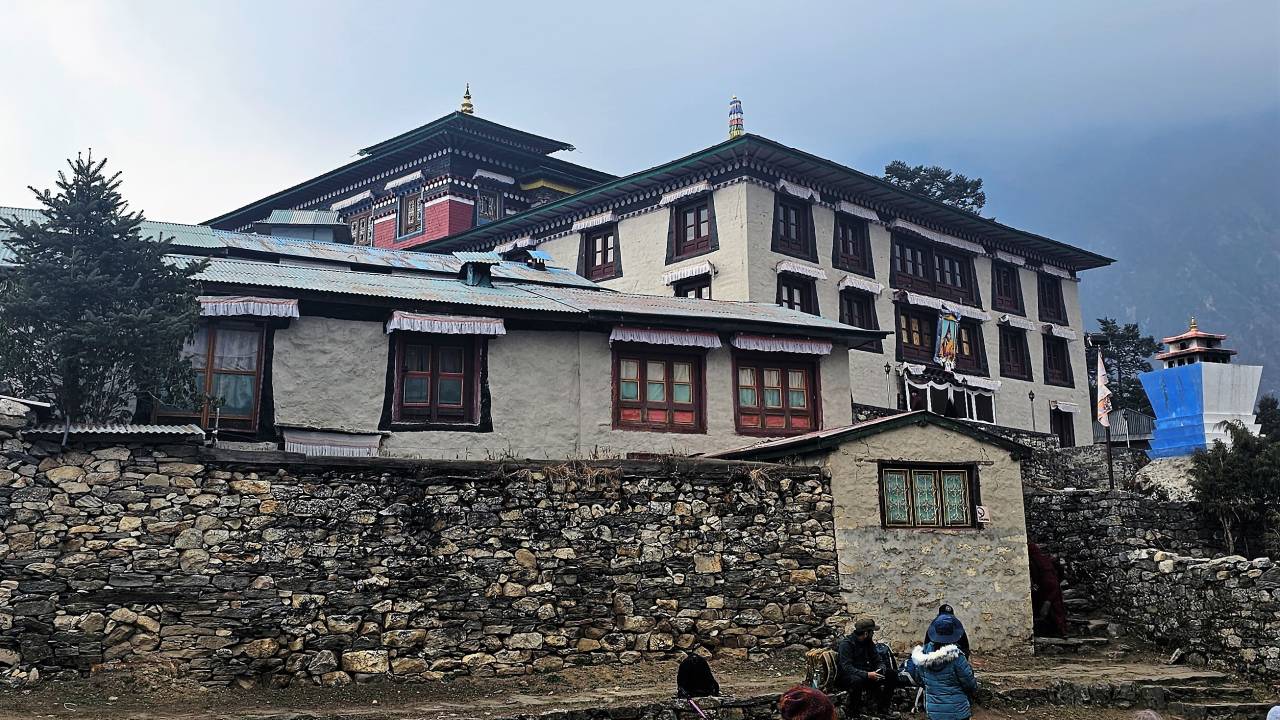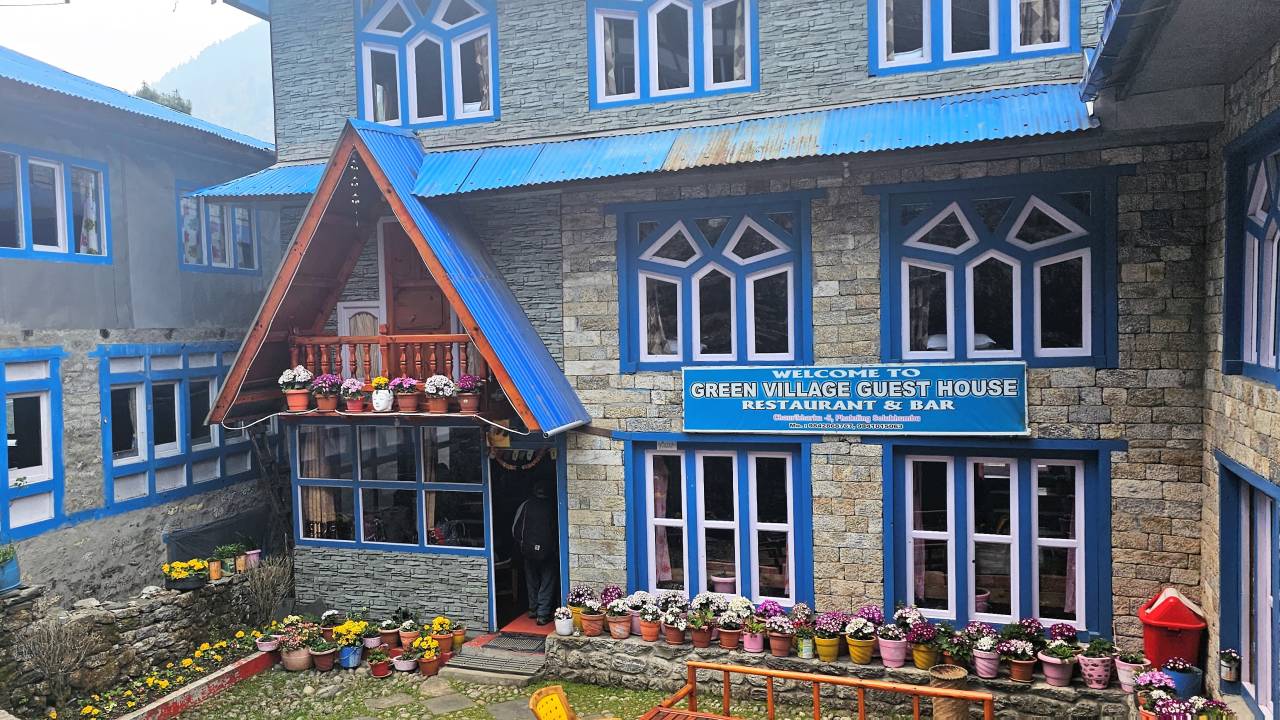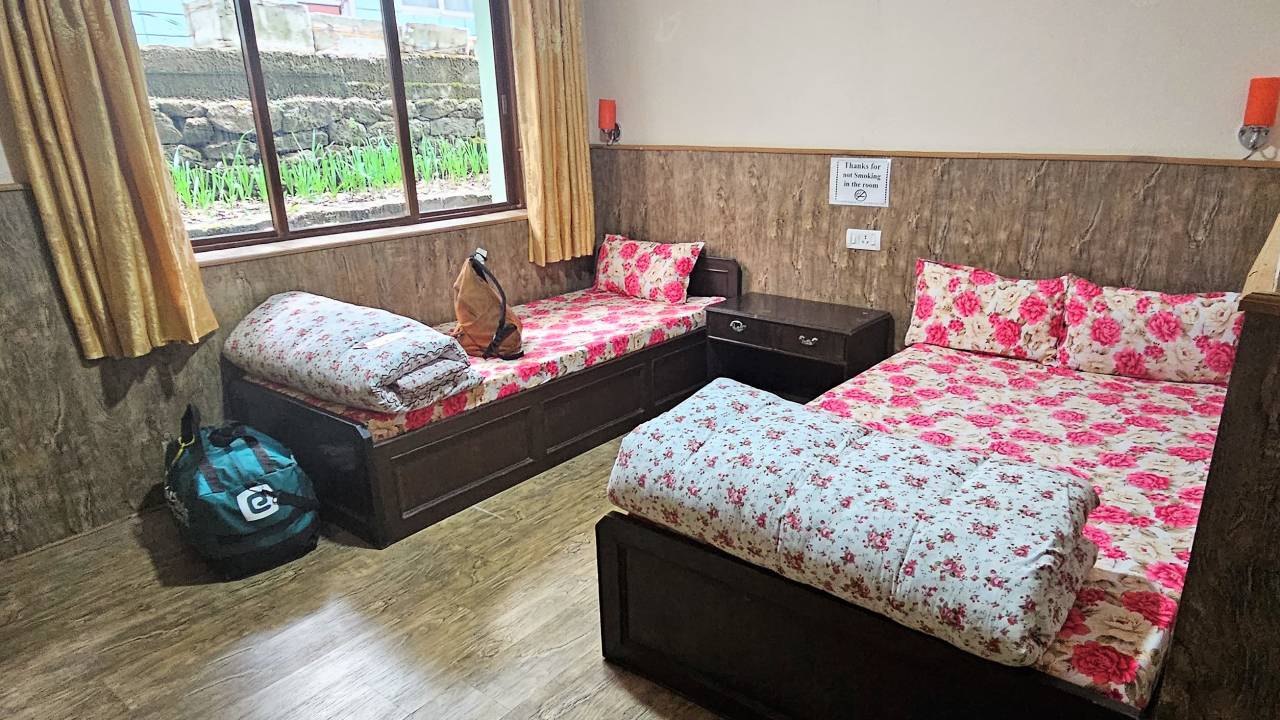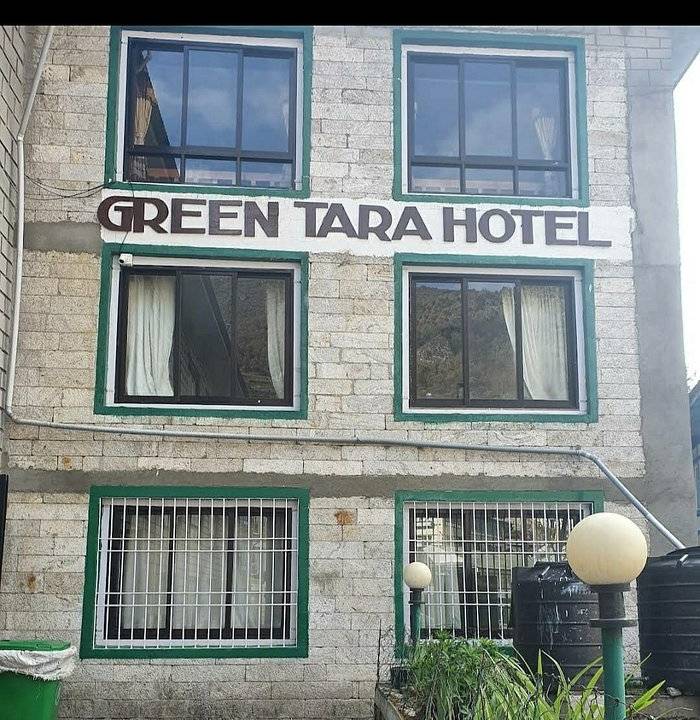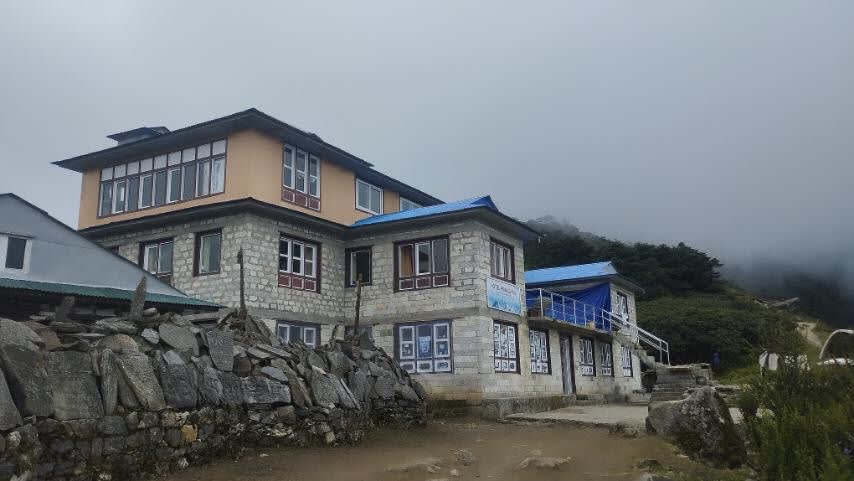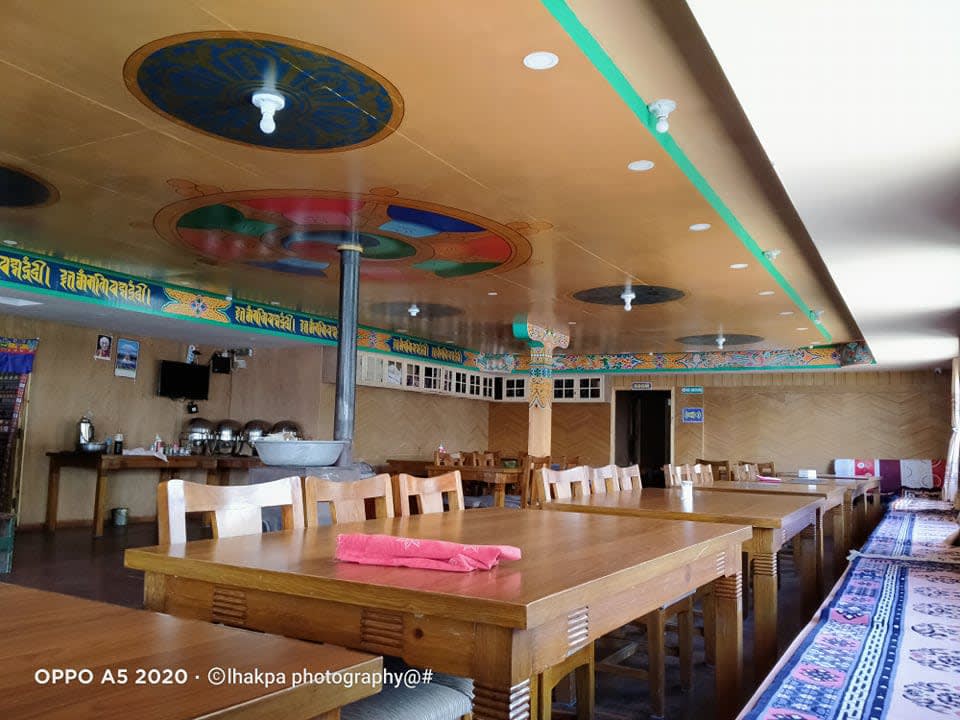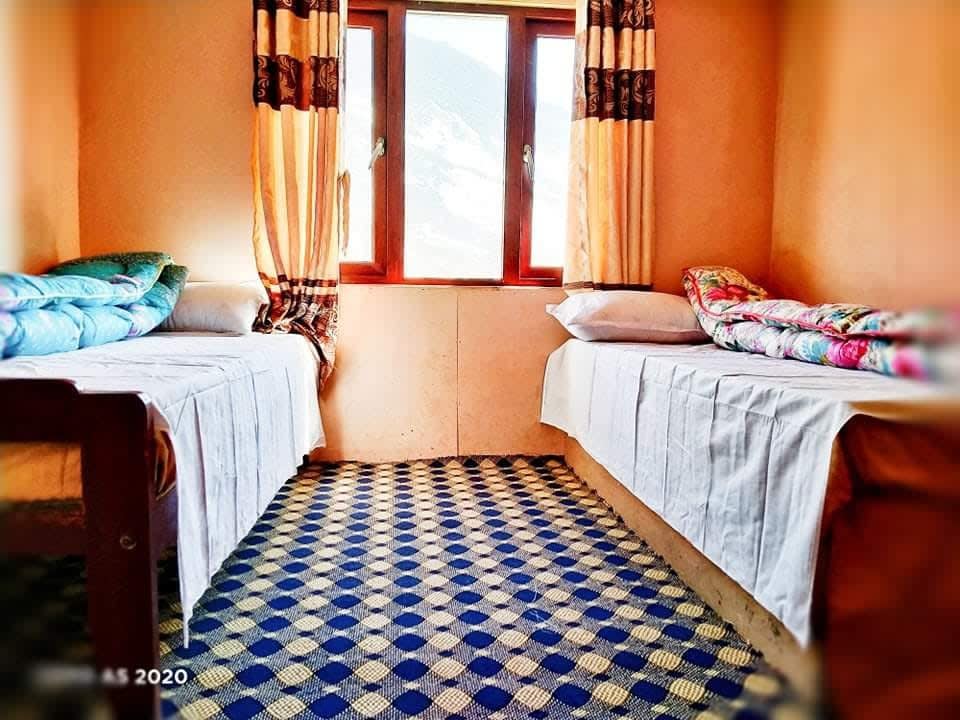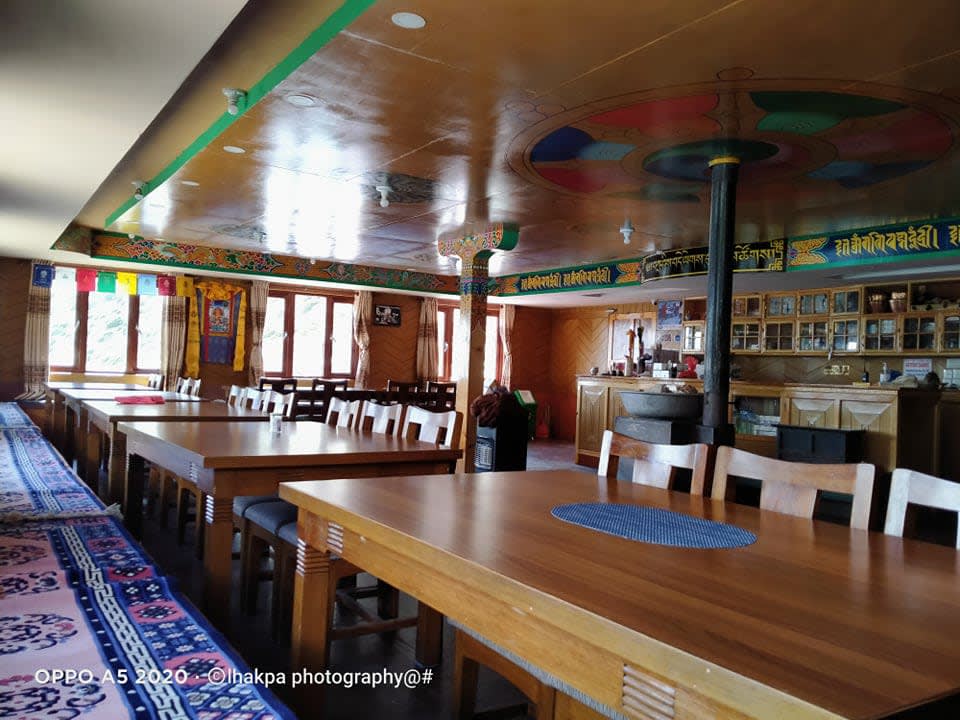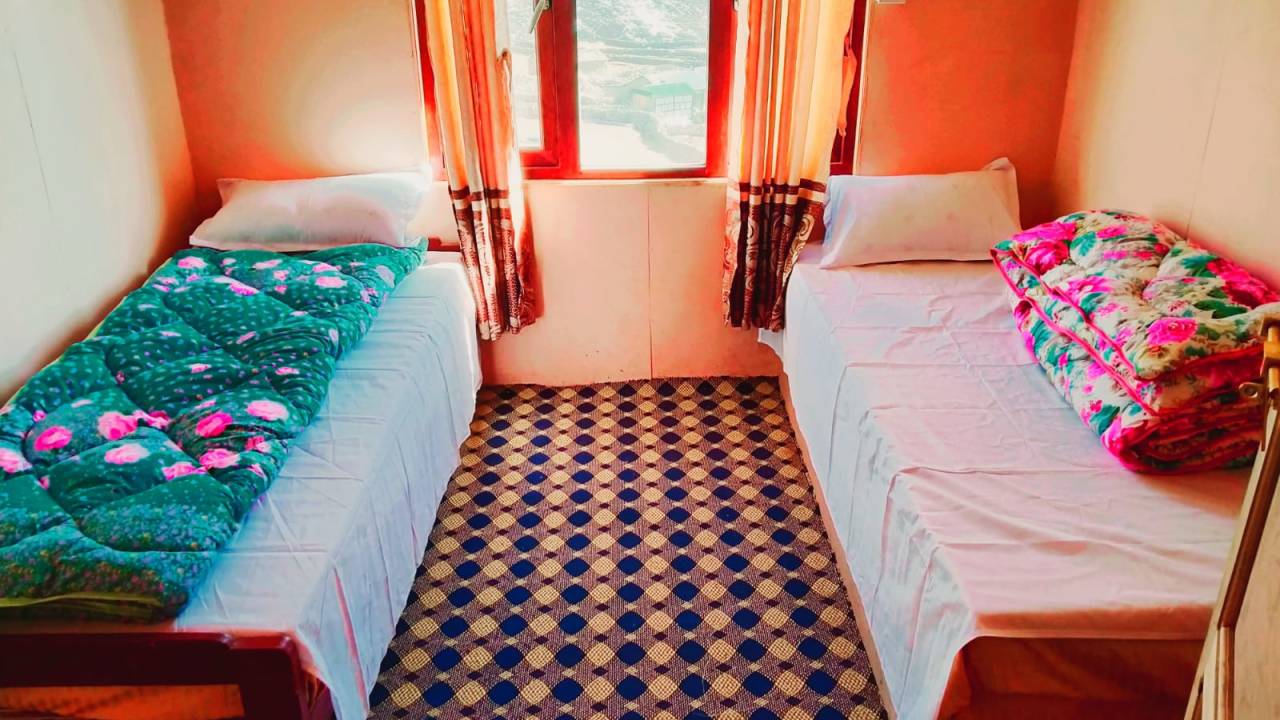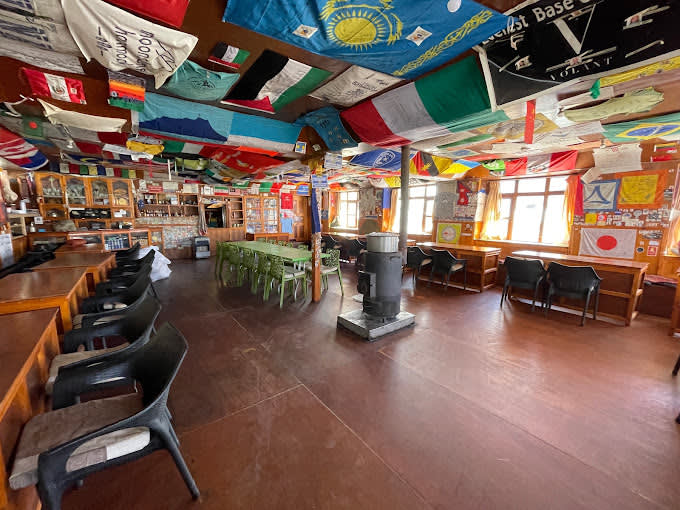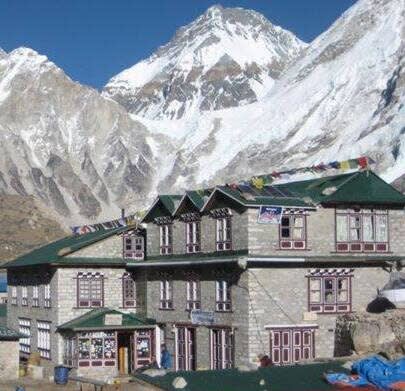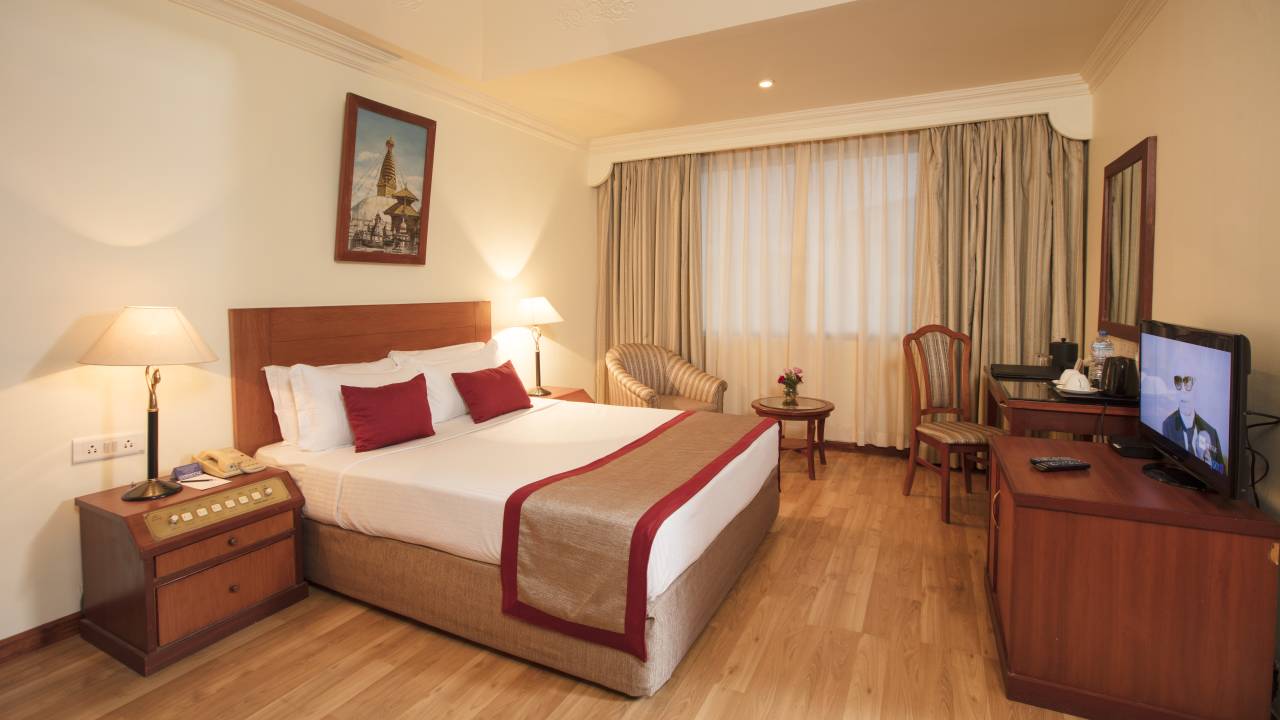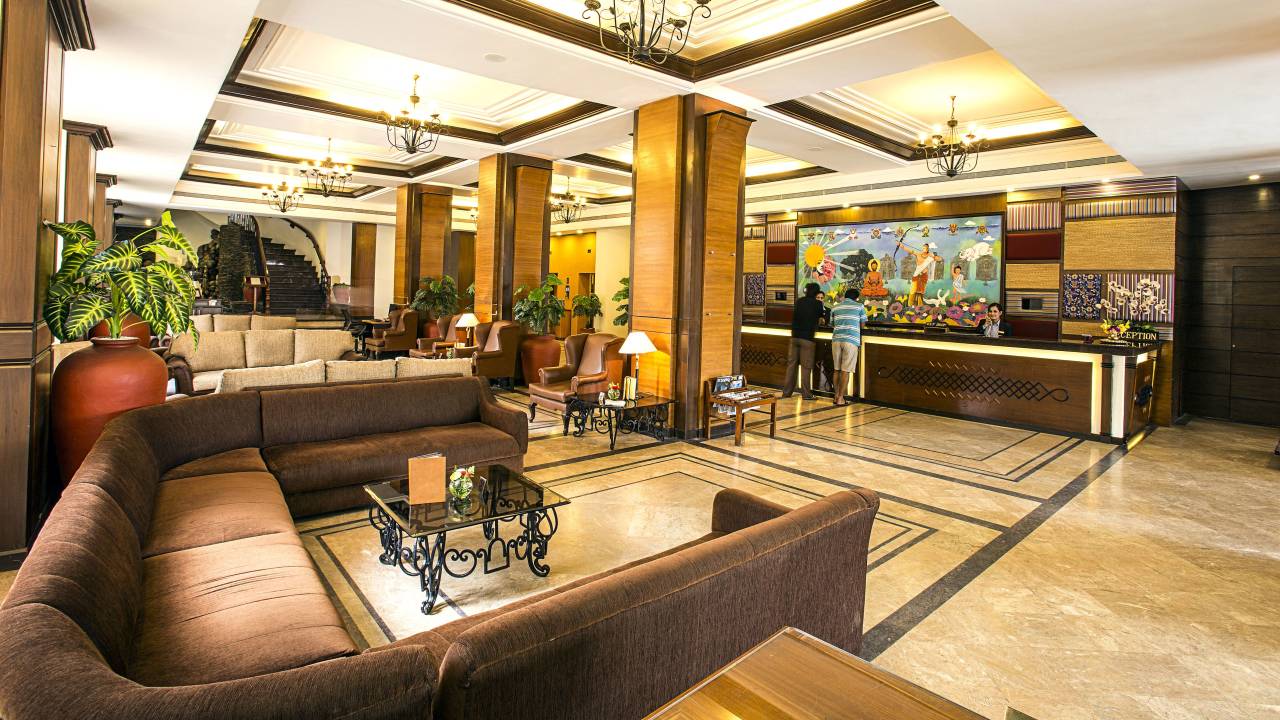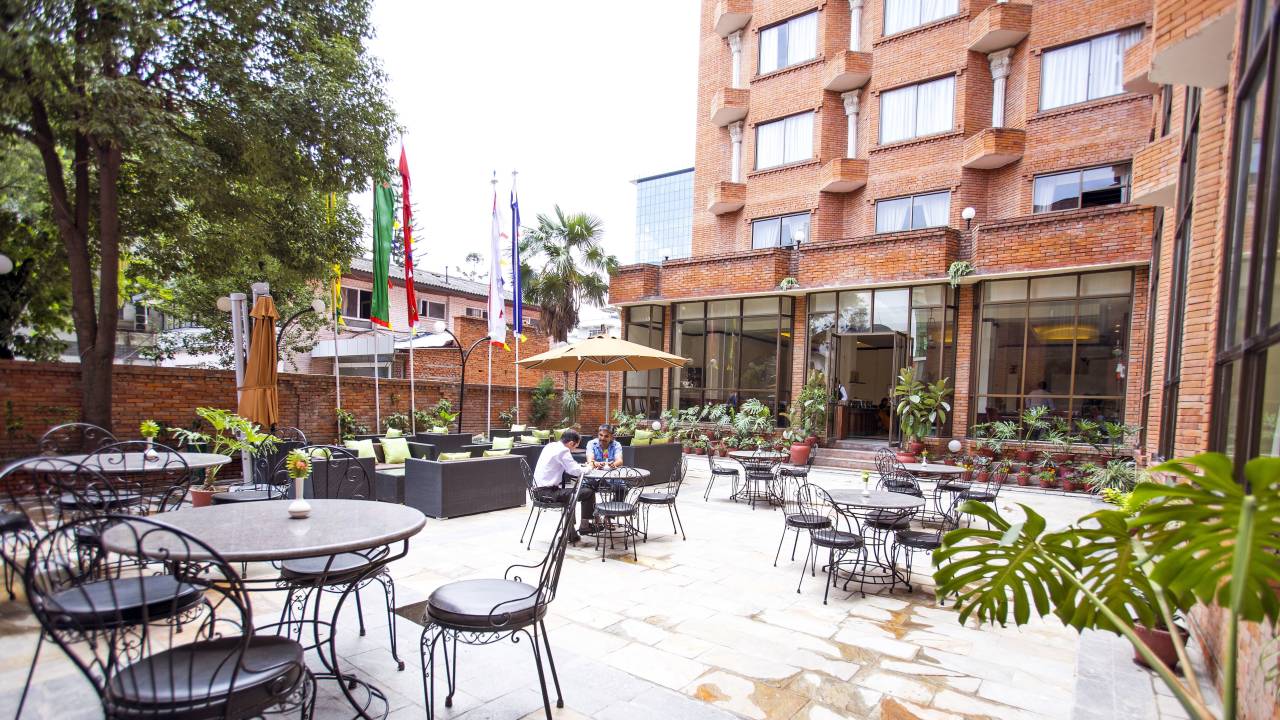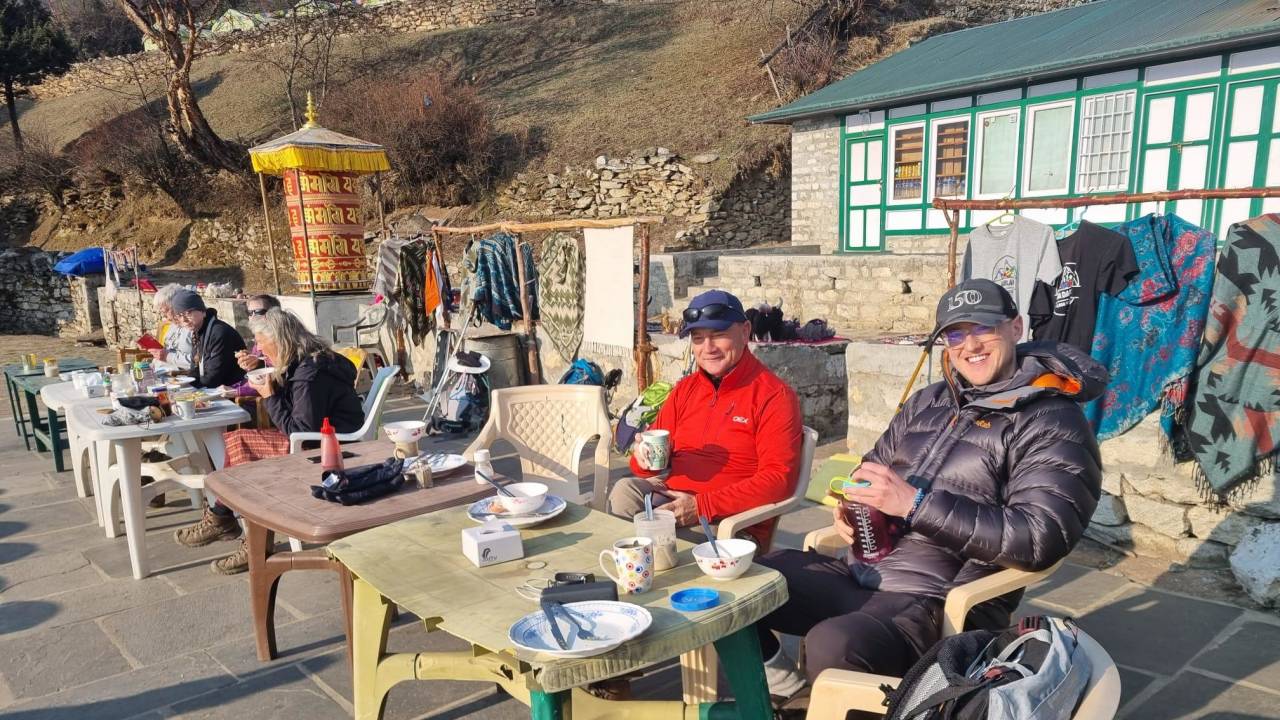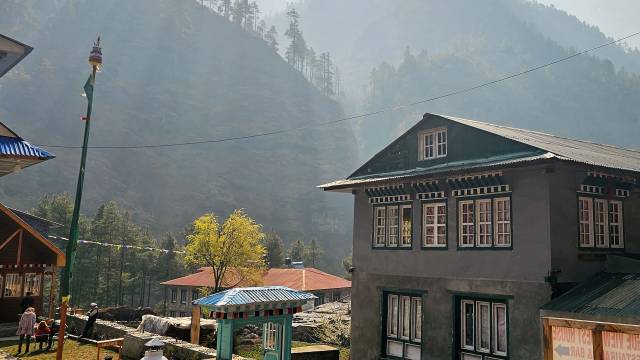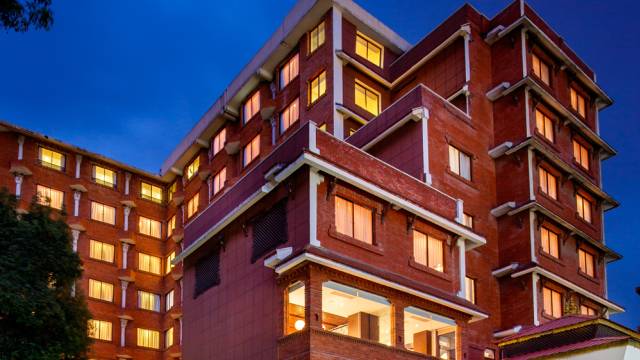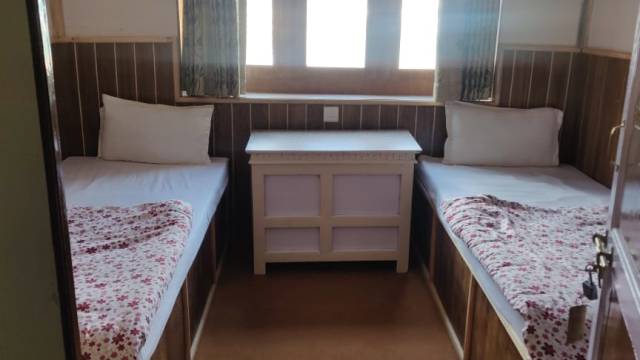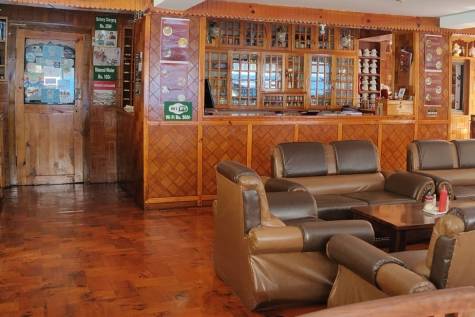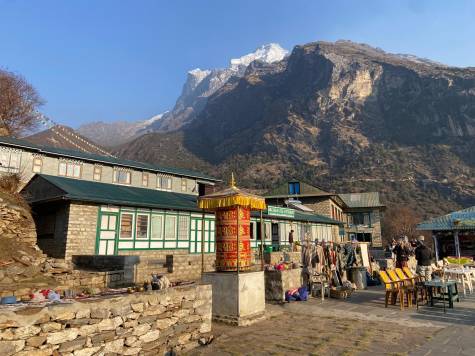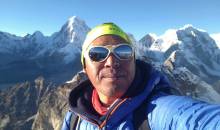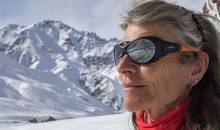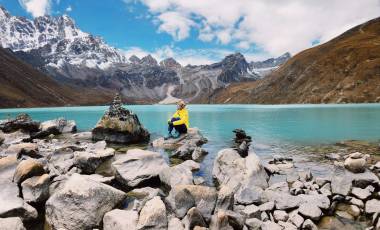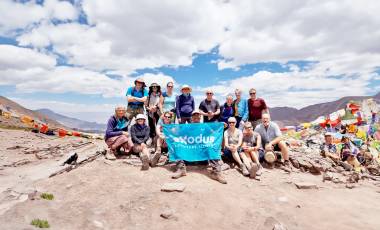- Walk the classic route to Everest Base Camp, a legendary trail
- See the Khumbu Icefall from Everest Base Camp and take a picture at the Base Camp rock
- Ascend Kala Pattar for unforgettable views of Mount Everest
- Explore the bustling Namche Bazaar to soak up Sherpa culture
- Visit the hilltop monastery at Thyangboche
- Visit Sagarmatha Next and support the effort to keep Everest’s trails trash free
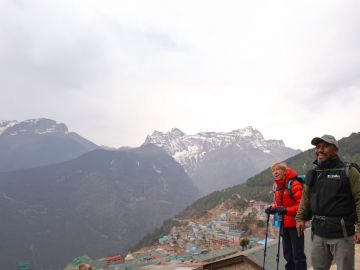
Everest Base Camp Trek
- Home
- Asia
- Nepal
- Walking & Trekking
- Everest Base Camp Trek
Start
Finish
Availability
Land Only Trip Price
Optional Single Supplement
Saturday Friday
06 Dec 2025 05 Dec 2025
Sunday Sunday
21 Dec 2025 21 Dec 2025
Availability
Guaranteed (On Request)
Land Only Trip Price USD 2695 USD 2695
Optional Single Supplement +USD 225
Availability
This departure is guaranteed to go ahead and can be booked, although some components will need to be requested. Please click Continue to proceed with booking or contact our Sales team for assistance.
View Trip NotesSaturday Friday
07 Mar 2026 06 Mar 2026
Sunday Sunday
22 Mar 2026 22 Mar 2026
Availability
Available
Land Only Trip Price USD 3415 Book with USD 853 deposit Book with USD 500 deposit
Optional Single Supplement +USD 248
Availability
This departure is available for new bookings, and will be guaranteed to go ahead once it reaches minimum numbers. Please click Continue to proceed with booking or contact our Sales team for assistance.
View Trip NotesThursday Wednesday
02 Apr 2026 01 Apr 2026
Sunday Monday
19 Apr 2026 20 Apr 2026
Availability
Guaranteed (Available)
Land Only Trip Price USD 4720 USD 4720 Book with USD 1180 deposit Book with USD 1180 deposit
Optional Single Supplement +USD 248
Availability
This departure is available for new bookings and has reached the minimum number of passengers required to go ahead. Please click Continue to proceed with booking or contact our Sales team for assistance.
View Trip NotesThursday Wednesday
09 Apr 2026 08 Apr 2026
Sunday Monday
26 Apr 2026 27 Apr 2026
Availability
Guaranteed (Available)
Land Only Trip Price USD 5845 USD 5845 Book with USD 1461 deposit Book with USD 1461 deposit
Optional Single Supplement
+USD 248
Available upon Request
Availability
This departure is available for new bookings and has reached the minimum number of passengers required to go ahead. Please click Continue to proceed with booking or contact our Sales team for assistance.
View Trip NotesSaturday Friday
11 Apr 2026 10 Apr 2026
Sunday Sunday
26 Apr 2026 26 Apr 2026
Availability
Guaranteed (Available)
Land Only Trip Price USD 3415 Book with USD 853 deposit Book with USD 500 deposit
Optional Single Supplement +USD 248
Availability
This departure is available for new bookings and has reached the minimum number of passengers required to go ahead. Please click Continue to proceed with booking or contact our Sales team for assistance.
View Trip NotesSaturday Friday
03 Oct 2026 02 Oct 2026
Sunday Sunday
18 Oct 2026 18 Oct 2026
Availability
Guaranteed (Available)
Land Only Trip Price USD 3445 Book with USD 861 deposit Book with USD 500 deposit
Optional Single Supplement +USD 248
Availability
This departure is available for new bookings and has reached the minimum number of passengers required to go ahead. Please click Continue to proceed with booking or contact our Sales team for assistance.
View Trip NotesSaturday Friday
17 Oct 2026 16 Oct 2026
Sunday Sunday
01 Nov 2026 01 Nov 2026
Availability
Available
Land Only Trip Price USD 3445 Book with USD 861 deposit Book with USD 500 deposit
Optional Single Supplement +USD 248
Availability
This departure is available for new bookings, and will be guaranteed to go ahead once it reaches minimum numbers. Please click Continue to proceed with booking or contact our Sales team for assistance.
View Trip NotesSaturday Friday
24 Oct 2026 23 Oct 2026
Sunday Sunday
08 Nov 2026 08 Nov 2026
Availability
Available
Land Only Trip Price USD 3595 Book with USD 898 deposit Book with USD 500 deposit
Optional Single Supplement +USD 248
Availability
This departure is available for new bookings, and will be guaranteed to go ahead once it reaches minimum numbers. Please click Continue to proceed with booking or contact our Sales team for assistance.
View Trip NotesSaturday Friday
31 Oct 2026 30 Oct 2026
Sunday Sunday
15 Nov 2026 15 Nov 2026
Availability
Guaranteed (Available)
Land Only Trip Price USD 3595 Book with USD 898 deposit Book with USD 500 deposit
Optional Single Supplement +USD 248
Availability
This departure is available for new bookings and has reached the minimum number of passengers required to go ahead. Please click Continue to proceed with booking or contact our Sales team for assistance.
View Trip NotesSaturday Friday
07 Nov 2026 06 Nov 2026
Sunday Sunday
22 Nov 2026 22 Nov 2026
Availability
Available
Land Only Trip Price USD 3595 Book with USD 898 deposit Book with USD 500 deposit
Optional Single Supplement +USD 248
Availability
This departure is available for new bookings, and will be guaranteed to go ahead once it reaches minimum numbers. Please click Continue to proceed with booking or contact our Sales team for assistance.
View Trip NotesSaturday Friday
14 Nov 2026 13 Nov 2026
Sunday Sunday
29 Nov 2026 29 Nov 2026
Availability
Guaranteed (Available)
Land Only Trip Price USD 3595 Book with USD 898 deposit Book with USD 500 deposit
Optional Single Supplement +USD 248
Availability
This departure is available for new bookings and has reached the minimum number of passengers required to go ahead. Please click Continue to proceed with booking or contact our Sales team for assistance.
View Trip NotesSaturday Friday
21 Nov 2026 20 Nov 2026
Sunday Sunday
06 Dec 2026 06 Dec 2026
Availability
Available
Land Only Trip Price USD 3595 Book with USD 898 deposit Book with USD 500 deposit
Optional Single Supplement +USD 248
Availability
This departure is available for new bookings, and will be guaranteed to go ahead once it reaches minimum numbers. Please click Continue to proceed with booking or contact our Sales team for assistance.
View Trip NotesSaturday Friday
28 Nov 2026 27 Nov 2026
Sunday Sunday
13 Dec 2026 13 Dec 2026
Availability
Available
Land Only Trip Price USD 3595 Book with USD 898 deposit Book with USD 500 deposit
Optional Single Supplement +USD 248
Availability
This departure is available for new bookings, and will be guaranteed to go ahead once it reaches minimum numbers. Please click Continue to proceed with booking or contact our Sales team for assistance.
View Trip NotesSaturday Friday
05 Dec 2026 04 Dec 2026
Sunday Sunday
20 Dec 2026 20 Dec 2026
Availability
Available
Land Only Trip Price USD 3595 Book with USD 898 deposit Book with USD 500 deposit
Optional Single Supplement +USD 248
Availability
This departure is available for new bookings, and will be guaranteed to go ahead once it reaches minimum numbers. Please click Continue to proceed with booking or contact our Sales team for assistance.
View Trip NotesSaturday Friday
12 Dec 2026 11 Dec 2026
Sunday Sunday
27 Dec 2026 27 Dec 2026
Availability
Available
Land Only Trip Price USD 3595 Book with USD 898 deposit Book with USD 500 deposit
Optional Single Supplement +USD 248
Availability
This departure is available for new bookings, and will be guaranteed to go ahead once it reaches minimum numbers. Please click Continue to proceed with booking or contact our Sales team for assistance.
View Trip NotesSaturday Friday
27 Feb 2027 26 Feb 2027
Sunday Sunday
14 Mar 2027 14 Mar 2027
Availability
Available
Land Only Trip Price USD 3445 Book with USD 861 deposit Book with USD 500 deposit
Optional Single Supplement +USD 248
Availability
This departure is available for new bookings, and will be guaranteed to go ahead once it reaches minimum numbers. Please click Continue to proceed with booking or contact our Sales team for assistance.
View Trip NotesThursday Wednesday
04 Mar 2027 03 Mar 2027
Friday Friday
19 Mar 2027 19 Mar 2027
Availability
Available
Land Only Trip Price USD 3445 Book with USD 861 deposit Book with USD 500 deposit
Optional Single Supplement +USD 248
Availability
This departure is available for new bookings, and will be guaranteed to go ahead once it reaches minimum numbers. Please click Continue to proceed with booking or contact our Sales team for assistance.
View Trip NotesSaturday Friday
20 Mar 2027 19 Mar 2027
Sunday Sunday
04 Apr 2027 04 Apr 2027
Availability
Available
Land Only Trip Price USD 3445 Book with USD 861 deposit Book with USD 500 deposit
Optional Single Supplement +USD 248
Availability
This departure is available for new bookings, and will be guaranteed to go ahead once it reaches minimum numbers. Please click Continue to proceed with booking or contact our Sales team for assistance.
View Trip NotesThursday Wednesday
25 Mar 2027 24 Mar 2027
Friday Friday
09 Apr 2027 09 Apr 2027
Availability
Available
Land Only Trip Price USD 3445 Book with USD 861 deposit Book with USD 500 deposit
Optional Single Supplement +USD 248
Availability
This departure is available for new bookings, and will be guaranteed to go ahead once it reaches minimum numbers. Please click Continue to proceed with booking or contact our Sales team for assistance.
View Trip NotesThursday Wednesday
01 Apr 2027 31 Mar 2027
Sunday Monday
18 Apr 2027 19 Apr 2027
Availability
Available
Land Only Trip Price USD 4795 USD 4795 Book with USD 1198 deposit Book with USD 1198 deposit
Optional Single Supplement +USD 248
Availability
This departure is available for new bookings, and will be guaranteed to go ahead once it reaches minimum numbers. Please click Continue to proceed with booking or contact our Sales team for assistance.
View Trip NotesSaturday Friday
03 Apr 2027 02 Apr 2027
Sunday Sunday
18 Apr 2027 18 Apr 2027
Availability
Available
Land Only Trip Price USD 3445 Book with USD 861 deposit Book with USD 500 deposit
Optional Single Supplement +USD 248
Availability
This departure is available for new bookings, and will be guaranteed to go ahead once it reaches minimum numbers. Please click Continue to proceed with booking or contact our Sales team for assistance.
View Trip NotesThursday Wednesday
08 Apr 2027 07 Apr 2027
Sunday Monday
25 Apr 2027 26 Apr 2027
Availability
Available
Land Only Trip Price USD 4795 USD 4795 Book with USD 1198 deposit Book with USD 1198 deposit
Optional Single Supplement +USD 248
Availability
This departure is available for new bookings, and will be guaranteed to go ahead once it reaches minimum numbers. Please click Continue to proceed with booking or contact our Sales team for assistance.
View Trip NotesSaturday Friday
10 Apr 2027 09 Apr 2027
Sunday Sunday
25 Apr 2027 25 Apr 2027
Availability
Available
Land Only Trip Price USD 3445 Book with USD 861 deposit Book with USD 500 deposit
Optional Single Supplement +USD 248
Availability
This departure is available for new bookings, and will be guaranteed to go ahead once it reaches minimum numbers. Please click Continue to proceed with booking or contact our Sales team for assistance.
View Trip NotesThursday Wednesday
15 Apr 2027 14 Apr 2027
Sunday Monday
02 May 2027 03 May 2027
Availability
Available
Land Only Trip Price USD 5995 USD 5995 Book with USD 1498 deposit Book with USD 1498 deposit
Optional Single Supplement +USD 248
Availability
This departure is available for new bookings, and will be guaranteed to go ahead once it reaches minimum numbers. Please click Continue to proceed with booking or contact our Sales team for assistance.
View Trip NotesSaturday Friday
17 Apr 2027 16 Apr 2027
Sunday Sunday
02 May 2027 02 May 2027
Availability
Available
Land Only Trip Price USD 3445 Book with USD 861 deposit Book with USD 500 deposit
Optional Single Supplement +USD 248
Availability
This departure is available for new bookings, and will be guaranteed to go ahead once it reaches minimum numbers. Please click Continue to proceed with booking or contact our Sales team for assistance.
View Trip NotesSaturday Friday
02 Oct 2027 01 Oct 2027
Sunday Sunday
17 Oct 2027 17 Oct 2027
Availability
Available
Land Only Trip Price USD 3445 Book with USD 861 deposit Book with USD 500 deposit
Optional Single Supplement +USD 263
Availability
This departure is available for new bookings, and will be guaranteed to go ahead once it reaches minimum numbers. Please click Continue to proceed with booking or contact our Sales team for assistance.
View Trip NotesThursday Wednesday
07 Oct 2027 06 Oct 2027
Friday Friday
22 Oct 2027 22 Oct 2027
Availability
Available
Land Only Trip Price USD 3445 Book with USD 861 deposit Book with USD 500 deposit
Optional Single Supplement +USD 263
Availability
This departure is available for new bookings, and will be guaranteed to go ahead once it reaches minimum numbers. Please click Continue to proceed with booking or contact our Sales team for assistance.
View Trip NotesSaturday Friday
16 Oct 2027 15 Oct 2027
Sunday Sunday
31 Oct 2027 31 Oct 2027
Availability
Available
Land Only Trip Price USD 3445 Book with USD 861 deposit Book with USD 500 deposit
Optional Single Supplement +USD 263
Availability
This departure is available for new bookings, and will be guaranteed to go ahead once it reaches minimum numbers. Please click Continue to proceed with booking or contact our Sales team for assistance.
View Trip NotesThursday Wednesday
21 Oct 2027 20 Oct 2027
Friday Friday
05 Nov 2027 05 Nov 2027
Availability
Available
Land Only Trip Price USD 3445 Book with USD 861 deposit Book with USD 500 deposit
Optional Single Supplement +USD 263
Availability
This departure is available for new bookings, and will be guaranteed to go ahead once it reaches minimum numbers. Please click Continue to proceed with booking or contact our Sales team for assistance.
View Trip NotesSaturday Friday
30 Oct 2027 29 Oct 2027
Sunday Sunday
14 Nov 2027 14 Nov 2027
Availability
Available
Land Only Trip Price USD 3445 Book with USD 861 deposit Book with USD 500 deposit
Optional Single Supplement +USD 263
Availability
This departure is available for new bookings, and will be guaranteed to go ahead once it reaches minimum numbers. Please click Continue to proceed with booking or contact our Sales team for assistance.
View Trip NotesThursday Wednesday
04 Nov 2027 03 Nov 2027
Friday Friday
19 Nov 2027 19 Nov 2027
Availability
Available
Land Only Trip Price USD 3445 Book with USD 861 deposit Book with USD 500 deposit
Optional Single Supplement +USD 263
Availability
This departure is available for new bookings, and will be guaranteed to go ahead once it reaches minimum numbers. Please click Continue to proceed with booking or contact our Sales team for assistance.
View Trip NotesSaturday Friday
13 Nov 2027 12 Nov 2027
Sunday Sunday
28 Nov 2027 28 Nov 2027
Availability
Available
Land Only Trip Price USD 3445 Book with USD 861 deposit Book with USD 500 deposit
Optional Single Supplement +USD 263
Availability
This departure is available for new bookings, and will be guaranteed to go ahead once it reaches minimum numbers. Please click Continue to proceed with booking or contact our Sales team for assistance.
View Trip NotesThursday Wednesday
18 Nov 2027 17 Nov 2027
Friday Friday
03 Dec 2027 03 Dec 2027
Availability
Available
Land Only Trip Price USD 3445 Book with USD 861 deposit Book with USD 500 deposit
Optional Single Supplement +USD 263
Availability
This departure is available for new bookings, and will be guaranteed to go ahead once it reaches minimum numbers. Please click Continue to proceed with booking or contact our Sales team for assistance.
View Trip NotesSaturday Friday
27 Nov 2027 26 Nov 2027
Sunday Sunday
12 Dec 2027 12 Dec 2027
Availability
Available
Land Only Trip Price USD 3445 Book with USD 861 deposit Book with USD 500 deposit
Optional Single Supplement +USD 263
Availability
This departure is available for new bookings, and will be guaranteed to go ahead once it reaches minimum numbers. Please click Continue to proceed with booking or contact our Sales team for assistance.
View Trip NotesThursday Wednesday
02 Dec 2027 01 Dec 2027
Friday Friday
17 Dec 2027 17 Dec 2027
Availability
Available
Land Only Trip Price USD 3445 Book with USD 861 deposit Book with USD 500 deposit
Optional Single Supplement +USD 263
Availability
This departure is available for new bookings, and will be guaranteed to go ahead once it reaches minimum numbers. Please click Continue to proceed with booking or contact our Sales team for assistance.
View Trip NotesSaturday Friday
11 Dec 2027 10 Dec 2027
Sunday Sunday
26 Dec 2027 26 Dec 2027
Availability
Available
Land Only Trip Price USD 3445 Book with USD 861 deposit Book with USD 500 deposit
Optional Single Supplement +USD 263
Availability
This departure is available for new bookings, and will be guaranteed to go ahead once it reaches minimum numbers. Please click Continue to proceed with booking or contact our Sales team for assistance.
View Trip NotesExtend Your Trip
Chitwan or Kathmandu Valley Add-on Tours
 Extend your adventure by joining one of our add on tours:
Extend your adventure by joining one of our add on tours:
Chitwan: This five-day wildlife adventure is a perfect chance to unwind in Nepal’s lowlands after your trek. From Kathmandu, travel to your jungle lodge near Chitwan National Park, where an expert naturalist will help you spot one-horned rhinos, birds, deer and more. See the full itinerary here.
Kathmandu Valley: Nestled in the Himalayan foothills, the Kathmandu Valley is a perfect prelude to your adventure. This short trek starts and ends in Kathmandu, with gentle trails through villages and rhododendron forests, and sweeping mountain views. See the full itinerary here.
Reviews
Add your own reviewEverest Base Camp Trek review by Julian Pomery
I’m 70. I had a yearning to see Everest since I was quite young. As I grew older, I hoped to do the trip with my sons but the length of the trip was not conducive. I wasn’t particularly fit but trained for a few months beforehand, not knowing if I could manage the amount of walking , let alone the unknown element of altitude.
Arriving in Kathmandu, the hotel was excellent and we had time to visit the old city of Thamel.
The flight to Lukla was a great experience in a small plane, next the start of the trek.
The ‘Teahouses’ along the way offered a warm convivial welcome, with varying numbers of other trekkers present. Suspension-bridge crossings, some several hundred metres long were great! We were lucky to have clear visibility and sunshine nearly every day as we progressed ever higher amid awe-inspiring scenery, expertly led by our leader Valerie Parkinson, and Nepalese guide Saroje. Our yakman Nawang took care of all our luggage except for our light daysacks.
We gazed up at Lhotse, Ama Dablam, Macalu, Pumori, to name but a few peaks. From various vantage points including the aptly named Everest View Hotel, we had excellent views of Everest with the South Summit and South Col.
We experienced at first hand the logistical marvel of how everything is transported up here; by yak, mule, dzo or porter.
Bird-life included Vultures and Golden Eagles soaring overhead, plus Tibetan Snow birds that took a fancy to my lemon drizzle cake on Kala Patthar during our final acclimatisation trek.
After taking in the Kumbhu Glacier, we reached Gorak Shep before the final push to Everest Base Camp itself. Unlike most other treks, we had ample time at Base Camp rock before the short walk to one of the expedition camps where we stayed overnight, amongst an array of camps looking like something out of a Bond movie. We witnessed a massive avalanche, and spent time on the ice shelf, truly surreal amongst the surrounding peaks.
Overall, it was tough but an utterly amazing experience, in the competent hands of our leader Valerie, a lifetime goal achieved.
Most Inspirational Moment
Spending time at Base Camp with the group. Also attending prayers at Thyangboche Monastery
Thoughts on Group Leader
Five Star.
Advice for Potential Travellers
Don't wait. Prepare well with your fitness. Tough, but a trip of a lifetime. Julian
Once in a lifetime trek
Absolutely amazing trip from start to finish. Met at the airport by a smiling Tenzi Sherpa, couldn’t have had a more welcoming greeting. Thorough briefing before an early start off into the mountains. Kept fully informed all the way along the trek. Always kept upbeat by Tenzis ready smile and laugh.
Stunning scenery and totally awe inspiring to walk among the highest mountains in the world.
Most Inspirational Moment
To walk among the highest mountains in the world to reach Everest Base Camp. Also to sit with a holy man on the flight to Lukla, a peaceful yet inspiring moment.
Thoughts on Group Leader
Tenzi was absolutly the best we could have had. We ran in to bad weather coming out of Lukla and could not fly he got us all organised smoothly to get off in a helicopter. Tenzi made sure we were all sure of what we were doing, when we were doing it and how. Always smiling and laughing yet solicitous to our every concern. Truly could not have had a better leader.
Advice for Potential Travellers
Train for it, it is tough.... but thoroughly enjoyable. Pack layers, it does get cold especially at night. Take wet wipes because no one wants to have a cold shower in freezing conditions! Enjoy it, it is a once in a lifetime experience.
Trip to a hiker's paradise
Everest Base Camp is a trip to remember. Starting in the bustling city of Kathmandu where you get the first impressions of Nepal. Hot and busy.
Followed by evening briefieng where you meet your group for the first time. Early morning start with the biggest adventure of getting on a small plane to Lukla 😀 Yes, the trails to Base camp can get busy. We were quite lucky that despite the busy season in April, we still had good amount of time walking alone as a group and passing others at the teahouses. The trek itself is not difficult. The pace is very slow to make sure you acclimatise well, but be prepared for long days of walking -albeit very slowly. We were so lucky to have clear skies coming up and the views were breathtaking. From the first time you get to see Mount Everest to being surrounded by the changing landscape of 6000+ metre giants. All of us made it to Base Camp together after 8 days of ups and downs. It really is an unforgettable trip and for me so much more about the journey itself, rather than stepping your foot in EBC. You get used to the life in the valley, locals, animals passing by, beautiful monasteries and everpresent prayer flags. Food is quite tasty and mostly carbs, which we all appreciated the colder it got. We were so well taken care of by our leader and guides and big thank you goes to them for making us safe and always well fed and happy 🙂
If you love mountains, I can only recommend this trip.
Most Inspirational Moment
Most inspiring would be all the views on day 8. You are finally high enough and surrounded by all the snow-covered giants with teahouses scattered along the way. The views just stunning and we were so lucky to have good weather and enjoy the views as we continued to Lobuche.
Thoughts on Group Leader
Our leader Kumar was a ray of sunshine ever since he picked us up from the airport. He was very kind, funny, knowledgeable and it was inspiring to hear his personal story of becoming a tour leader. It was great to have a local guide for we got to understand the culture and people so much more. He covered many topics from religion, marriage, history of Nepal and daily life.
Advice for Potential Travellers
Pack plenty of layers, hot water bottle and walking poles. Bring some of your favourite snack and power bank - these can get quite pricey as you walk up.
Trip of a lifetime!
I took part in the Exodus Everest Base Camp trip in March and had an incredible time!
Everything was so well organised. The guides were so professional and great at their jobs. My group and I were in very safe and capable hands.
The itinerary was fantastic. It was so beautiful hiking to Everest Base Camp. Every day was an adventure and there were fun things for us to do and see on a daily basis. I appreciated the inclusion of visiting schools, monasteries, museums etc. on the trip – it added a nice extra dimension to the hiking.
We had a group of 6 travellers which was a nice number and it was nice being part of a team. We all made it to Base Camp which was fantastic news.
This was my first trip with Exodus however after this I will definitely be going on more trips with them!
Most Inspirational Moment
Reaching Base Camp!
Thoughts on Group Leader
Tenzi Sherpa
Advice for Potential Travellers
Pack playing cards - my group and I played Uno every night and it was a nice way to bond and chill out at the end of a hard day's walking!
Everest and its luscious landscape
Regarding the Everest base camp trek, It was in one simple word Breath-taking. Over the 2 weeks we got to see the incredible Sagarmatha national park in all its glory, we lucked out as it was sunny throughout and seeing the picturesque landscape is something to behold. From the Alpine forests of the lower valley passing the milky river. To the highlands of the Khumbu Glacier en route to Base camp. Every step is something special.
Most Inspirational Moment
Walking through the entrance of Sagarmatha national park and seeing the incredible valley for the 1st time and randomly having hundreds of dragonfly's pass by as we entered, felt like we entered a mythical world.
Thoughts on Group Leader
DB was a very gracious, outstanding and knowledgeable leader, who great to talk with and know the valley like the back of his hand
EBC - An excellent experience
My recent trip to Everest Base Camp was an amazing experience which completely exceeded my expectations. The scenery was breath-taking, the sights & sounds of Nepal were stunning and the company of the group & guidance of out leader all made for an unforgetable trek. Although I knew what to expect from research & reading – seeing 6000, 7000 & finally 8,000m snow capped mountains with my own eyes was something I will always remember.
Most Inspirational Moment
Reaching the summit of Kala Pathar (5,644m) is the highest I have ever been. The sense of achievement at completing the climb and the views it provided across to Everest were a highlight for me.
Thoughts on Group Leader
Our leader was Valerie Parkinson, who was simply the best! Val provided huge insight into the history & traditions of the Himalayas as well as sharing her own experiences climbing high altitude peaks such as Manaslu & Everest itself. She was an incredibly calm & reassuring influence on the group and ensured we kept to a sensible pace - despite us wanting to take thousands of photos - without rushing us along. Our evening discussions over dinnner with Val, really enhanced the whole experience.
Advice for Potential Travellers
On our trek (November) - when the sun came out, temperatures reached 25C - so layers including T-shirts & possibly shorts will ensure you do not overheat - particularly when trekking up hill. Similarly, temperatures in the evening are very cold so you need to have plenty of warm clothing. The Lodges do not have any heating other than in the dining area - so be prepared for cold bedrooms. A water bottle of boiling water in the evening can be used as a hot water bottle in bed and then as drinking water the day after. I used AquaTabs to purify drinking water. They worked perfectly, with zero after taste. Some members of the group had issues with cold batteries in electronic purifiers e.g. Steripens. Lobuche & Gorak Shep are very cold - with no running water due to frozen pipes. Be prepared!
Our trek to Everest Base Camp
In retrospect, the trip was the experience of a life-time, but always enjoyable at the time and we believe there are things Exodus Travels could do to make this tough expedition easier for future trekkers. Obviously the walking was tough, although my wife and I are seasoned trekkers and knew what to expect. Regarding the route itself, we did wonder whether an overnight stay at Pangboche instead of Phakding would make the trek-day to Namche easier? Also, we question whether a ‘B Plan’ would be possible in case of bad weather at the high end of the trail ? We reached Gorak Shep by lunch-time on 1st May and would have gone on to Base Camp, but heavy snow prevented that and in order to ‘summit’ we had to start early the next day to reach Base Camp, return and then walk down to Pheriche, which made for a very long day. We appreciate that it seldom snows in May, but the local people are finding that that pattern is altering as the global climate is changing. There somehow needs to be a ‘spare’ day in case of bad weather.
Accommodation’
This was probably our main area of concern; we knew to expect that these would be ‘spartan’ but this does not excuse the extent of filth in several cases: at Labouche, mould was clearly evident on the bedding, and at Gorak Shep, the one ‘western’ toilet seat was not only cracked and broken, but underneath it was encrusted with human waste. As someone once said, you can see what the bathrooms are like, but not the kitchens!
As for the bathrooms in general, we found at Namche there was no washbasin anywhere except in the corridors, which was the only place where you might brush your teeth, but you obviously could not have a proper (strip!) wash in a corridor in full view of the public! There were 2 showers in that tea-house but one was filthy, obviously not regularly cleaned.
At Lukla, there was an under floor water-leak, so that whenever taps were turned on in our room, the carpet in the room and outside in the corridor became immediately soaked. Showers were not available there and in a few other tea-houses – we had to rely on paying extra for a hot bowl of water.
At Tengboche, we passed by several newly–built-looking hotels before reaching our tea-house which was much the poorer. (We met other trekkers who had stayed in the newer accommodation and spoke favourably. We wondered there as at Namche why Exodus appeared not to have chosen the best option for accommodation.
But there were some good, clean tea-houses; Chhumoa and Khyangjuma were clean and comfortable, as was the newly-built tea-house at Dingboche, which boasted electric blankets. Could this ‘luxury’ not be provided elsewhere, as would make overnight stays much more comfortable – we enjoyed our two nights there. Pheriche was also clean and relatively comfortable; we saw the toilets being cleaned out by staff in the morning…
The most important omission we found was means of (international) communication in the tea-houses in case of emergency. When our daughter became ill and clearly could not continue the trek down from Pheriche, we found it impossible to contact our insurers back in the UK before organising a helicopter. In order to send just one email, we used the tea-house landlord’s phone positioned in one particular part of a window to get just ‘one bar’ of phone reception; a satellite phone in each tea-house would help in situations such as ours.
Possibly the most potentially serious issue we had was on the trail out of Namche, where we encountered a herd of yaks descending towards us across the entire trail. On one side was a vertical bank, and on the other a sheer drop.
The yaks were moving fast and their driver who was at the back was as much use as a chocolate fire-guard.
Our tour-leader said to move to the side by the bank, but then the yaks veered in our direction, threatening to crush us against the rocks. So we were advised to swap to the other side, and the yaks followed us. Whilst they narrowly missed our daughter and me, they knocked my wife over who was scrambling to avoid being swept over the edge.
The yak driver did not respond to our shouts of concern, and more worryingly, our tour leader did not appear overly concerned and just said that it was ‘crazy’. I think there needs to be some extra care and training given to tour leaders to avoid what could have been a fatal accident in our case.
Most Inspirational Moment
We loved trekking in the mornings especially when there was sunshine and views of the scenery could clearly be seen and we had many such mornings like this, including having breakfast outside at Khyangjuma. The acclimatisation walk above Namche to the Everest View Hotel was also fantastic, and although the weather at Gorak Shep made for a precipitous trek to Base Camp, it was amazing to see the expedition tents there and to see the snow 'formations' across the Base Camp plateau. Equally inspirational were our sherpas who made the trip for us and couldn't do enough for us, especially Lhakpa I (the older Lhakpa) and Kami who were as attentive to our comforts as they could possibly be, finding the best place to dry towels for us, always there with hot drinks and bringing/ taking away crockery at meal-times, as well as much more. When our daughter could not continue the trek due to a flu-type virus, it was Lhakpa I who stayed with her at Dingboche and Pheriche. When with us on the trail he always set a steady pace, dealt with all the paperwork at checkpoints and was clearly the most experienced among the tour leaders/ guides. But it was Kami and Lhakpa II who were with us on the icy boulder-field walk to base camp and Kami who prevented me from slipping countless times. We tipped the three sherpas generously, but would liked to have given them more. We found the Nepali people friendly and helpful, and our three Sherpas were good ambassadors for the Nepali people. We were pleased with the efficiency of the evacuation by helicopter for our daughter, which enabled us to continue with the trek. (The helicopter pilot was a Canadian who we'd met staying in Lukla - he'd also helped sort out the plumbing problems in our accommodation for us, so we were fglad the helicopter pilot who flew our daughter to Lukla was someone we knew!
Thoughts on Group Leader
We were less happy with Aniche, our principal group leader. He put in lots of time with us when we arrived early both in Kathmandu and Lukla, helping show us round Kathmandu and waiting for several hours beyond the expected flight arrival in Kathmandu. As the trek went on, however he appeared less confident in our abilities and his own, frequently asking us if we should abandon our trek and descend, when we had slight headaches. At Gorakshep, he announced that he did not feel well and decided to leave us with our Sherpas, organising a replacement (Khusman) although the latter did not reach us until we had completed the Base Camp walk. He took a helicopter back to Lukla, then on to Kathmandu, leaving us with Khusman who had had to alter his aranged leave and family time in order to join us at Base Camp on Monday 2nd May. On our arrival in Kathmandu, Anish was there waiting for us clearly expecting to resume his position, which Khusman respected. (We wondered whether the awarding of potential tips had anything to do with this.) At dinner on one of the last evenings Anish confided that he was unsure whether high-level guiding was right for him ( given the apparent symptoms he'd had, although he didn't look that ill to us.) He speculated whether lower-level backpacking or water sports activities might suit him better. We were glad we hadn't known this at the start of the trek, concluding all in all that he didn't seem very experienced or have much self-assurance. We were pleased that Khusman was able to step into the breach at short notice, and enjoyed trekking with him. When we returned to Kathamandu and Anish re-surfaced, Khusman tactfully faded into the background.
Advice for Potential Travellers
Make sure you have winter trekking equipment with you in case it snows on the summit attempt, even if you're told it shouldn't be necessary. Also ensure you have quick-drying towels and waterproof gear; we were lucky that the tea-houses werent that busy when we needed to dry our kit. Don't rely on Wifi - it's very patchy; an Ncell local SIM card is more useful. Get a good battery pack - it's not always possible to charge your phones. Keep a careful watch out for the yaks - they nearly did for us!!
Just amazing, and tough!
My wife and I had long wanted to do this trek and when the 45th anniversary deal came up we booked last Feb.
We then had months of worrying if we would make it, training, more training, buying gear, more gear etc etc!
We needn’t have worried. Our whole group made it thanks to Bikash and his team who were incredible throughout.
Bikash ensured we ate enough (lots!), drank enough water (lots!), kept our hats on (haha) and made sure we did everything possible to avoid altitude sickness and make it. Whatever he did worked!
We saw people in other groups dropping like flies and being helivac’d out. But we (11of us) were all fine!
I have been on many Exodus trips but on this one the group dynamic was exceptional. The teamwork and camaraderie were second to none. I guess because the trek is very challenging.
Don’t underestimate this trek, it is very tough!
Most Inspirational Moment
Getting to base camp itself after all the self-doubt we had about making it. Sitting quietly on my own looking at the vastness of the mountains around me. It's spectacular. But everywhere you trek is spectacular. Base camp is simply a highlight among many.
Thoughts on Group Leader
Exceptional. Bikash was a fantastic leader along with his team of Kami, Lakpar and Yak man (haha). We would not have made it without these guys!
Advice for Potential Travellers
Do not underestimate this hike. it is tough. Make sure you are fit! It's not a race. Go as slow as you can. The guides set the pace. Follow it. Its cold so bring some good layers and rent the sleeping bag at least. The bag was very good quality. A Steripen was very useful. A thick fleece and or lightweight down/thermoball gilet (or better still jacket) is very useful inside the tea houses. Only the main room is heated and then usually only for the evening. Only eat veggie food and dont drink alcohol while on the trek. We avoided any illness as a result. Try and sit on the left of the plane going to Lukla. Luggage is advised at 5kg carry on and 10kg check in. As a result I ditched some stuff at the start hotel but it turned out we could definitely take more. One of our guys had over 14kg check-in and its very cheap to pay the extra. Handwarmers were useful but only on EBC day really. We didnt need the many we brought! The recommended money to take on the trek was spot on.
The most amazing trip I have ever taken with memories never forgotten.
If you wish to challenge yourself and witness some of the most amazing views on the face of this planet then this is the trek for you.
Yes, you need to train, Yes you need to have a positive mind set, Yes, you will get cold, Yes you will NOT be staying in 5star hotels along your trek.
YES, you will find things out about yourself, YES you will do things that you never though possible.
YES YES YES you will have the greatest time.
Go ahead. Book it.
Most Inspirational Moment
Reaching Everest Base Camp as a compete team and seeing the Nepalese culture of how little they have and yet they smile every day are grateful for everything.
Thoughts on Group Leader
Ha Ha Tenzing Sherpa was the most positive and inspirational leader anyone could ask for. His knowledge and character and laughter was simply infectious. I would request him again to guide any trip.
Advice for Potential Travellers
Dont overpack Take enough underwear and socks Limit to a 2/3. base layers/ Mid layers and let the down jacket do the rest. Drink enough water even if you feel you are not thirsty. Avoid meat on the trek.
Trip of a lifetime!
What a truly amazing trip! The trip of a lifetime in fact. Stunning views, amazing camaraderie, almost to too many fantastic memories to process. Everything from the spectacular flight into Lukla, to crossing the stunning bridges felt like such an adventure, straight out of an Indiana Jones movie.
Special mention to our amazing tour leader Bikash Tamang and his amazing team (Kami Sherpa and Lakpa Cerpa) – these guys absolutely made the trip. So hard working, great sense of humour, super encouraging, super caring for the whole group, total professionals.
When we return we want exactly the same team, we miss you guys!
Most Inspirational Moment
Too many to count - seeing Everest for the first time, visiting the Tengboche monastery, making it to basecamp and experiencing the amazing camaraderie of the whole group including Bikash Tamang and his amazing Exodus Nepal team (Kami Sherpa and Lakpa Cerpa)
Thoughts on Group Leader
Bikash Tamang was the reason we all had one of the greatest trips of our lives. A true professional who was constantly encouraging the group and looking out for us all at every step of the way.
Advice for Potential Travellers
Make sure you train before the trip. Don't rush. Listen to everything your tour leader says and do it. They are extremely experienced.
You may also like
The Adventure Begins Here
Get regular inspiration straight to your inbox from Exodus’ experts.


